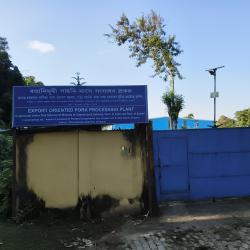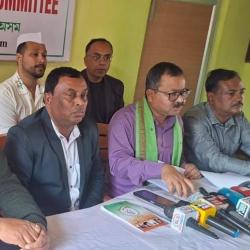Marking a significant milestone for conservation of Amur falcons in the northeast Indian state of Nagaland, three villages in Wokha district have pledged to save the migratory raptor in Doyang Reservoir - its largest roosting site in the country. With mass annual hunt potentially threatening the species, a resolution has been cleared by the villages to penalise offenders, this year onwards.
Village Council Members (VCM) of Pangti, Asshaa and Sungro signed a tri-party Memorandum of Understanding with the Wildlife Trust of India (WTI) and the Wokha-based NGO Natural Nagas, to assist the Nagaland Forest Department to stop the wide-scale hunt which was brought to light last year.
Tens of thousands of these raptors were reportedly hunted annually for their meat in the district, as they crossed the region en route to Africa from Siberia. Hunters turned their fishing nets upwards near the reservoir to trap the birds when they come to roost during late evenings or while leaving early in the morning.
“Following a report on the hunting of Amur Falcons by Conservation India, a Rapid Action Project (RAP) was initiated by WTI and Natural Nagas to spread awareness on the plight of the species among the local communities,” said Steve Odyuo, Natural Nagas.
The RAP, supported by the Charities Aid Foundation (CAF), approached the village councils for their help in preventing the hunt. A number of awareness meets and discussions held over the past few months, eventually culminated in signing of the MoU this week, encompassing a wide range of issues focusing on Amur falcon conservation.
The three parties will now be working together to spread the awareness among the public through various channels. The team will also work to reduce jhumming (slash-and-burn cultivation) to protect the roosting habitat of the species.
As agreed in the MoU, a resolution was passed by the village committees to fine hunters up to five thousand rupees. Protection groups engaging local youth from the three villages will be created to keep watch and ensure enforcement of the resolution to protect the birds this season.
Sancsuo Shiciri, VCM – Asshaa, said, “This is a new thing for the people here. The way WTI and Natural Nagas have come forward for the constructive approach for the conservation of Amur falcons, I think will bring a positive change in the future. We will give full support in every activity for the conservation of Amur falcons.”
Concurring with him and thanking the RAP team for motivating and helping bring about change from the grassroots, Ronchamo Shiciri, VCM – Pangti, added, “We give full support for conservation of Amur falcons and as well as to other species of wildlife.”
Ezanbemo Ngullie, Secretary, Village Development Board – Sungro, said, “The initiatives of WTI and Natural Nagas, has helped people know the importance of Amur falcons. We are always with them and will support to stop the killing and hunting of Amur falcons in the coming season.”
“Conservation will only be successful if it happens from within, and in this case we are extremely grateful to the village councils for taking the cause forward,” said Sunil Kyarong, Regional Head – WTI. “The best thing about the RAP was that the village councils sincerely acknowledged the problem and themselves came forward with potential solutions.”
“We have already begun implementing some solutions. For example, the hunt was predominantly carried out for meat, and so we have helped over 30 families that were involved in hunting the falcons set up poultry farms and trained them for the proper care ,” added Odyuo. The initiative has been welcomed and being enthusiastically sustained by the local people. The poultry farms are being regularly monitored by Natural Nagas and WTI is placing a full time sociologist to work with the communities on a long-term basis.
Working with the local communities and governments, WTI has implemented numerous successful RAPs across the country. Among the notable ones in northeast India was the facilitation of use artificial hornbill beaks in traditional head gear of the Nyishi tribe in Arunachal Pradesh.
- 8189 reads










Add new comment